Psychology Topic 4: The Brain and Neuropsychology
1/64
Earn XP
Description and Tags
How does your brain affect you?
Name | Mastery | Learn | Test | Matching | Spaced |
|---|
No study sessions yet.
65 Terms
Brain
The organ in your head
Made up of nerves that process info + controls complex behaviour
* Right hemisphere on the right side
* Left hemisphere on the left
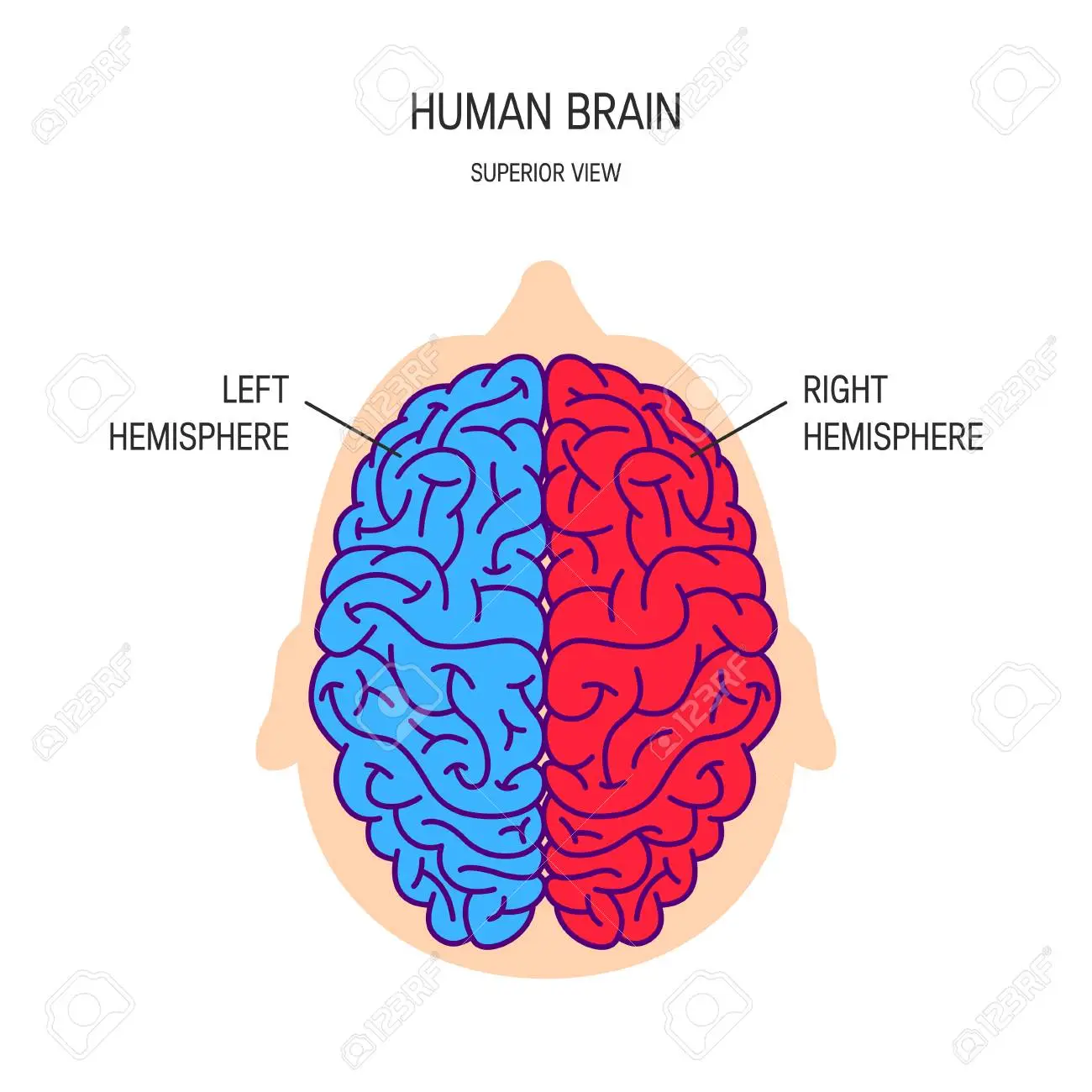
* **Upper** part of the brain
* **Has an** outer cortex
* Has lots of **folds** to i**ncrease its surface area**
* The ‘bumps‘ on the surface
* Creases on the surface
* Sulci (‘a sulcus’)
* This allows it to **control more functions**
* So the need less surface area in the brain
* It **connects** the brain to the rest of the **body** through the **peripheral nervous system**
* Controls **reflexes**
* They don’t require conscious thought
Frontal lobe
The area at the front of the brain responsible for decision-making + impulse control
Helps control problem-solving skills
Helps us concentrate and pay attention to different activities
* A large area just in **front** of the central sulcus
* Plays a key role in the **voluntary movements**
Temporal lobe
The area on the side of the brain that controls hearing + memory
Helps hear/understand sounds
Helps understand /create speech
Contains the auditory cortex (controls hearing)
Parietal lobe
The area at the top of the brain important for perception and sensations of touch
Contains the somatosensory cortex- sense of touch
* Contains the **visual cortex**
* Helps us **process visual information** from our eyes
* Helps make sense of this information so we **understand** what we are seeing
* Vital role in **motor skills**- movement, coordination and balance
* Takes information from the senses, spinal cord and other parts of the brain and then combines them to coordinate behaviour
* The message is sent via the spinal cord
1. The cerebellum combines this information and sends a message back to the body
2. It tells it to move to avoid the object.
3. This message is sent via the spinal cord
4. It tells us to change direction while helping us keep our balance
* So we do not fall as we dodge the object in our way
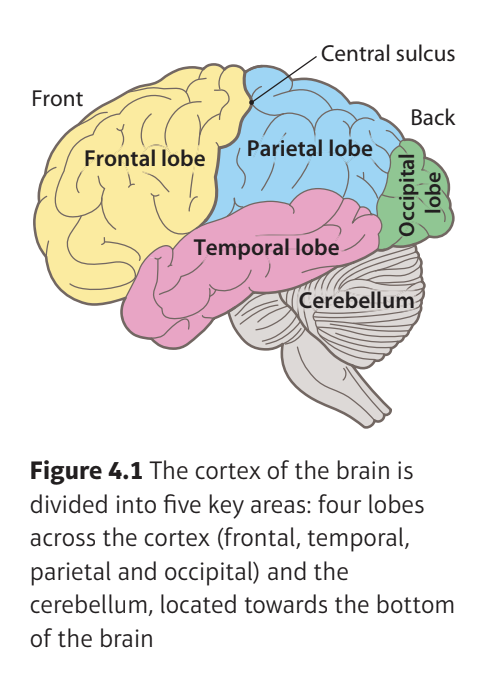
* Each hemisphere will have different specialist roles
How is the brain asymmetrical?
2 hemispheres of brain = not exactly the same, in terms of structure + function
Each hemisphere controls diff functions + plays a larger or smaller role in a particular behaviour
* Right side of the brain controls functions on the left side of the body
Corpus callosum
A thick bundle of nerve fibres that connect the right + left hemisphere of the brain so they can communicate w each other
So whole brain can work as 1 complete organ
The 2 hemispheres retain their own roles while working together to control behaviour in the whole body
What does the left hemisphere control?
Logical thinking
Broca’s area controls the production of speech
BA controls nerve cells in our face that help us speak
Processing of language-based info
Ability to write + understand lang
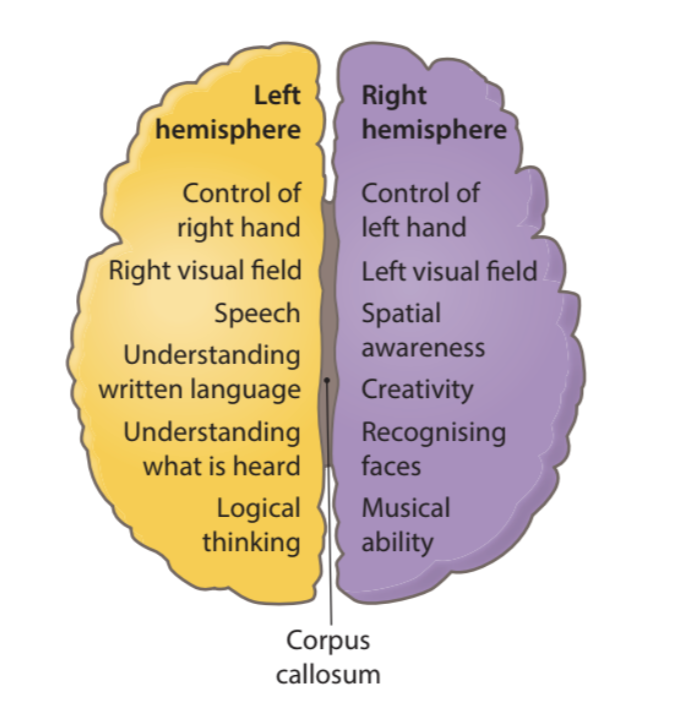
* Stuttering
* Difficult to identify objects verbally
Spatial awareness
The ability to negotiate space + navigate our way around our environment
What does the right hemisphere control?
Creativity
Spatial awareness
Ability to recognise + perceive faces
Processing of music
Making sense of visual info that we see
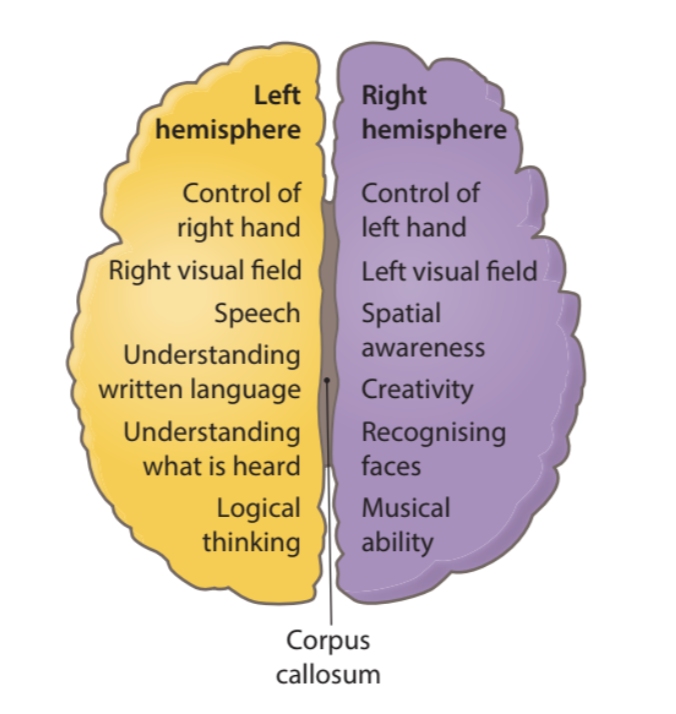
How does the corpus callosum play a role when you hear something spoken in your left ear?
Info passes to the R hemisphere of the brain
Info passed to the L hemisphere to be decoded so brain understands what was said
Info passed to the right hand for the person to write down what they heard
Sex differences in brain lateralisation and why (what did people think before)?
(how do males and females have brains that work differently?)
Females → better at language skills (left-brain tasks)
Females may have a thicker corpus callosum
Males → better at spatial skills (right-brain tasks)
What does it mean if females have a thicker corpus callosum?
They use both sides of their brain for tasks
Males show dominance for 1 hemisphere for the same tasks
More activity in 1 hemisphere than the other, rather than an equal spread of activity
* Spinal cords
What does the central nervous system (CNS) do?
Helps brain + body communicate w one another
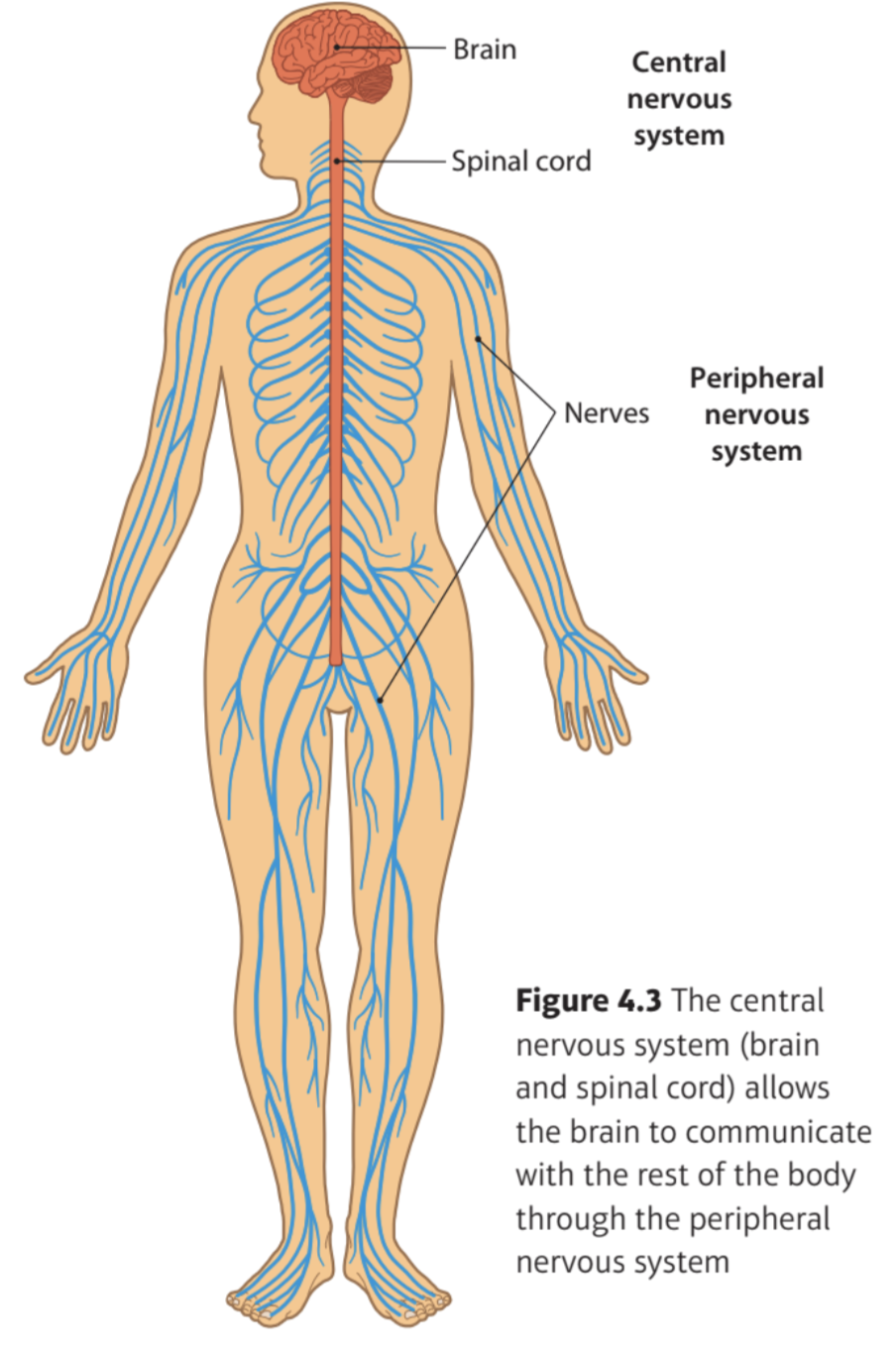
How does the central nervous system (CNS) work?
Brain sends messages to the body
Messages initially carried thru the spinal cord (sensory nerves)
Spinal cord activates the PNS
Sensory nerves
Located in the skin, muscles or organs
Take information into the nervous system
Peripheral nervous system (PNS)
System of nerves that connect the CNS to the skin muscles + organs in the body
Activated by the spinal cord
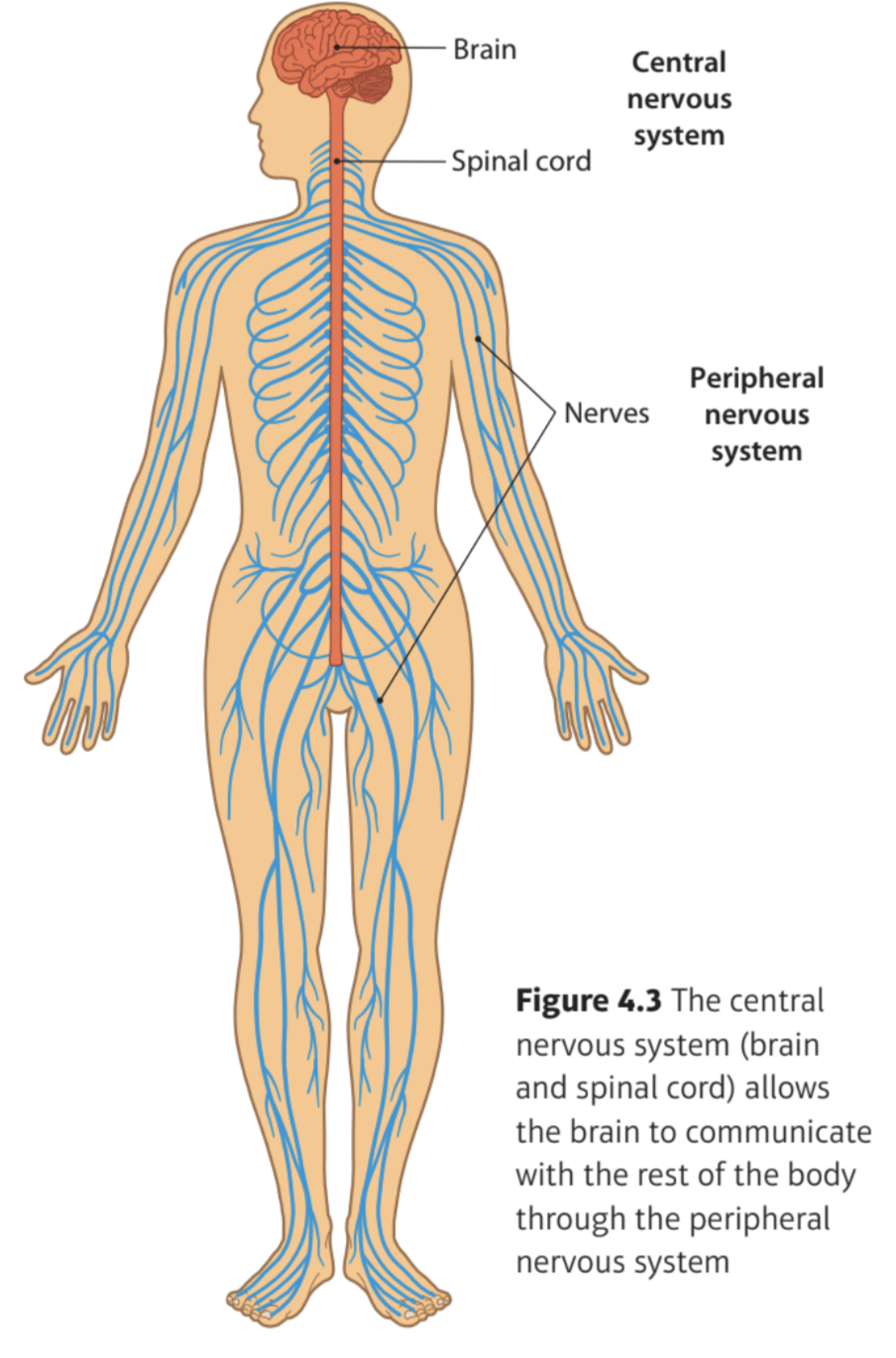
Neurotransmitters
Chemicals released from neurons that pass messages from nerve cell to another across a synapse
Neurotransmitters and their roles
Dopamine
Serotonin
GABA
Dopamine- attention and learning
Serotonin- mood
GABA- calms us down
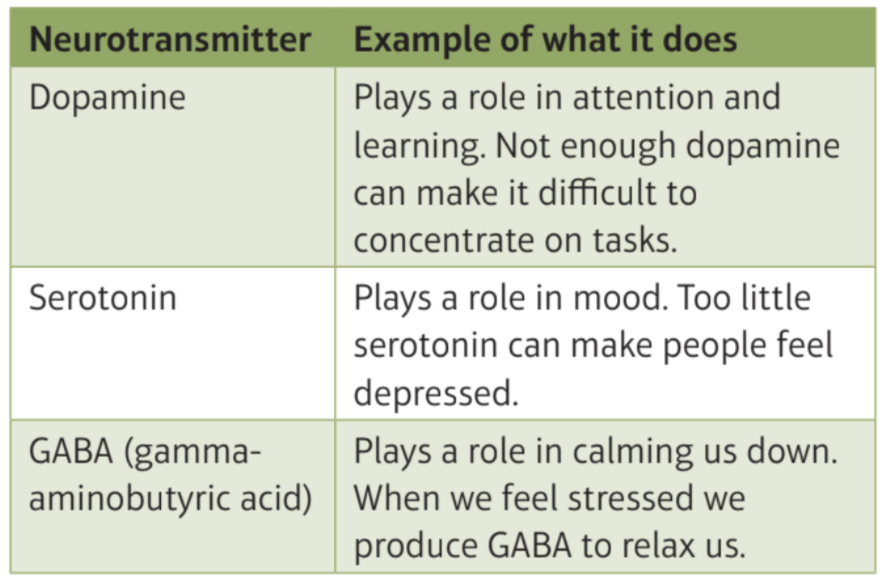
When are neurotransmitters released and what happens to it?
When a nerve impulse reaches the end of a nerve fibre
Neurotransmitter picked up by another neuron to receive the message + continue the NI
Synaptic transmission
The process by which neurotransmitters are released by a neuron, move across the synaptic gap + are then taken up by another neuron
* Filled with tiny sacs called vesicles
* Contain neurotransmitters
Synaptic functioning
Messages are passed throughout the nervous system, from one neuron to the next, by synaptic transmission
An electrical impulse is triggered inside the cell body of a neuron
The neuron then passes a small impulse along the axon towards the end of the nerve fibre
When the nerve impulse reaches the terminal button, the vesicles release the neurotransmitter molecules into the synapse
These molecules are ‘grabbed’ by the receptors on the next neuron to pass the message impulse on
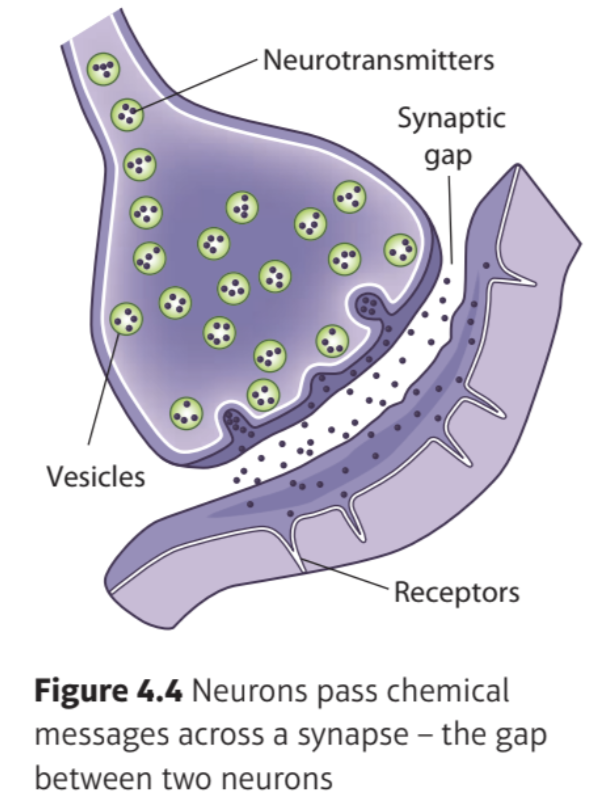
Neurological damage
Damage to the body’s CNS and PNS
Agnosia
Inability to interpret sensations → unable to make sense of the info/recognise something
Issue in the way the brain processes sensory information
* Disorder of perception
* Result of damage to the parietal lobe
* Can see the object in front of them perfectly but their brain can’t make sense of this information.
Difficulties of a person with visual agnosia
Info sent from eyes to brain can’t be understood → person can’t recognise things they can see
Recognizing objects
Due to impairments in basic perceptual processing or higher-level recognition processes.
Understanding another person’s identity
Perceiving shapes or forms
Symptoms of visual agnosia
(different symptoms depending on the type of visual information the brain cannot understand)
Patients may not be able recognise:
The colour of an object
Objects and name them
Places they are familiar with.
* Inability to recognise faces even though they can be seen
* Eyes send information to the brain about the face, but the brain can’t recognise who the face belongs to
* Near the back of the temporal lobe
* Next to the occipital lobe
Some patients:
1. See all faces as ‘the same’ and can’t tell faces apart
2. Can’t recognise faces of people that they know really well
3. Have trouble matching up pictures of faces that they don’t know
* Immediately behind the forehead
What does the Pre-frontal cortex control?
Impulses, decision-making, and rational thinking
Stops you from doing something like hitting someone when you are angry
Helps keep our emotions balanced so that we do not get too emotional
No matter what emotion we are feeling
* Difficult for people to control their emotions
* So their personality changes a lot
* People are more likely to commit crimes that they would not have done before
* He compared these to a similar group of people who had not committed murder
What did Adrian Raine et al. (1997) find and what was it used to show?
There were differences in the pre-frontal cortex of the two groups.
Murderers had less activity in the pre-frontal cortex
Making them more impulsive and aggressive
Explains why some people are more prone to violent and impulsive behaviour than others
* Consists mainly of nerve fibres (axons)
* Where neurons pass messages along axon fibres
* They cut down the corpus callosum to disconnect the right and left hemisphere

1. Someone with a split-brain cannot exchange information between the 2 hemispheres
2. So if information goes to the right of both eyes (left hemisphere) and comes into the left hand (right hemisphere) the person cannot match the two pieces of information